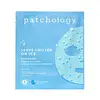What's inside
What's inside
 Key Ingredients
Key Ingredients

 Benefits
Benefits

 Concerns
Concerns

 Ingredients Side-by-side
Ingredients Side-by-side

Rubus Chamaemorus Fruit Extract
AntioxidantBakuchiol
AntimicrobialAvena Sativa Peptide
Skin ConditioningWater
Skin ConditioningGlycerin
HumectantDipropylene Glycol
HumectantCeratonia Siliqua Gum
EmollientErythritol
HumectantChondrus Crispus Powder
Abrasive1,2-Hexanediol
Skin ConditioningChondrus Crispus Extract
Skin ConditioningButylene Glycol
HumectantCellulose Gum
Emulsion StabilisingPaeonia Suffruticosa Root Extract
Skin ProtectingCentella Asiatica Extract
CleansingAlgin
MaskingChamomilla Recutita Flower Extract
MaskingPotassium Chloride
Glyceryl Caprylate
EmollientDextrin
AbsorbentSucrose
HumectantPolysorbate 20
EmulsifyingCI 77891
Cosmetic ColorantEthylhexylglycerin
Skin ConditioningSodium Hyaluronate
HumectantGardenia Florida Fruit Extract
Skin ConditioningPolymethylsilsesquioxane
Methyl Diisopropyl Propionamide
MaskingSilica
AbrasiveMenthyl Lactate
MaskingUrea
BufferingYeast Amino Acids
HumectantBetaine
HumectantInositol
HumectantTaurine
BufferingTrehalose
HumectantPolyglyceryl-10 Laurate
Skin ConditioningPotassium Sorbate
PreservativeTripeptide-1
Skin ConditioningAcetyl Tetrapeptide-2
Skin ConditioningAcetyl Tetrapeptide-5
HumectantCopper Tripeptide-1
Skin ConditioningPalmitoyl Tripeptide-1
Skin ConditioningPalmitoyl Pentapeptide-4
Skin ConditioningHexapeptide-11
Skin ConditioningHexapeptide-9
Skin ConditioningPalmitoyl Tripeptide-5
Skin ConditioningDisodium EDTA
Phenoxyethanol
PreservativeParfum
MaskingLimonene
PerfumingAlpha-Isomethyl Ionone
PerfumingCI 77007
Cosmetic ColorantRubus Chamaemorus Fruit Extract, Bakuchiol, Avena Sativa Peptide, Water, Glycerin, Dipropylene Glycol, Ceratonia Siliqua Gum, Erythritol, Chondrus Crispus Powder, 1,2-Hexanediol, Chondrus Crispus Extract, Butylene Glycol, Cellulose Gum, Paeonia Suffruticosa Root Extract, Centella Asiatica Extract, Algin, Chamomilla Recutita Flower Extract, Potassium Chloride, Glyceryl Caprylate, Dextrin, Sucrose, Polysorbate 20, CI 77891, Ethylhexylglycerin, Sodium Hyaluronate, Gardenia Florida Fruit Extract, Polymethylsilsesquioxane, Methyl Diisopropyl Propionamide, Silica, Menthyl Lactate, Urea, Yeast Amino Acids, Betaine, Inositol, Taurine, Trehalose, Polyglyceryl-10 Laurate, Potassium Sorbate, Tripeptide-1, Acetyl Tetrapeptide-2, Acetyl Tetrapeptide-5, Copper Tripeptide-1, Palmitoyl Tripeptide-1, Palmitoyl Pentapeptide-4, Hexapeptide-11, Hexapeptide-9, Palmitoyl Tripeptide-5, Disodium EDTA, Phenoxyethanol, Parfum, Limonene, Alpha-Isomethyl Ionone, CI 77007
Water
Skin ConditioningPentylene Glycol
Skin ConditioningGlycerin
HumectantAlgin
MaskingLithium Magnesium Sodium Silicate
AbsorbentSodium Hyaluronate
HumectantOryza Sativa Powder
Xanthan Gum
EmulsifyingConchiolin Powder
AbrasiveSodium Hydroxide
BufferingCitric Acid
BufferingTetrasodium Glutamate Diacetate
Anthemis Nobilis Flower Oil
MaskingMentha Viridis Leaf Oil
AstringentBenzyl Alcohol
PerfumingDehydroacetic Acid
PreservativeCI 42090
Cosmetic ColorantGlucose
HumectantCI 77231
Cosmetic ColorantTetrasodium Pyrophosphate
BufferingMagnesium Oxide
AbsorbentWater, Pentylene Glycol, Glycerin, Algin, Lithium Magnesium Sodium Silicate, Sodium Hyaluronate, Oryza Sativa Powder, Xanthan Gum, Conchiolin Powder, Sodium Hydroxide, Citric Acid, Tetrasodium Glutamate Diacetate, Anthemis Nobilis Flower Oil, Mentha Viridis Leaf Oil, Benzyl Alcohol, Dehydroacetic Acid, CI 42090, Glucose, CI 77231, Tetrasodium Pyrophosphate, Magnesium Oxide
Ingredients Explained
These ingredients are found in both products.
Ingredients higher up in an ingredient list are typically present in a larger amount.
Algin is brown algae. Algae is an informal term for a group of aquatic organisms that can photosynthesize. It is estimated there are at least 30,000 types of Algae.
Algae contains antioxidants. Antioxidants help fight free-radicals. Free-radicals are molecules that may damage your skin cells, such as pollution.
Glycerin is already naturally found in your skin. It helps moisturize and protect your skin.
A study from 2016 found glycerin to be more effective as a humectant than AHAs and hyaluronic acid.
As a humectant, it helps the skin stay hydrated by pulling moisture to your skin. The low molecular weight of glycerin allows it to pull moisture into the deeper layers of your skin.
Hydrated skin improves your skin barrier; Your skin barrier helps protect against irritants and bacteria.
Glycerin has also been found to have antimicrobial and antiviral properties. Due to these properties, glycerin is often used in wound and burn treatments.
In cosmetics, glycerin is usually derived from plants such as soybean or palm. However, it can also be sourced from animals, such as tallow or animal fat.
This ingredient is organic, colorless, odorless, and non-toxic.
Glycerin is the name for this ingredient in American English. British English uses Glycerol/Glycerine.
Learn more about GlycerinSodium Hyaluronate is hyaluronic acid's salt form. It is commonly derived from the sodium salt of hyaluronic acid.
Like hyaluronic acid, it is great at holding water and acts as a humectant. This makes it a great skin hydrating ingredient.
Sodium Hyaluronate is naturally occurring in our bodies and is mostly found in eye fluid and joints.
These are some other common types of Hyaluronic Acid:
Learn more about Sodium HyaluronateWater. It's the most common cosmetic ingredient of all. You'll usually see it at the top of ingredient lists, meaning that it makes up the largest part of the product.
So why is it so popular? Water most often acts as a solvent - this means that it helps dissolve other ingredients into the formulation.
You'll also recognize water as that liquid we all need to stay alive. If you see this, drink a glass of water. Stay hydrated!
Learn more about Water